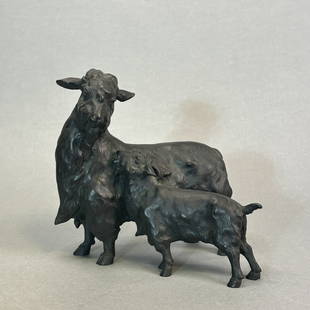

















Item Details
Description
An Interesting Edo-Period Japanese Katana with 39-Character Tameshi Giri (Cutting Test) Mei
29" nagasa. 44" overall with tsuka and saya. Large shinogi-zukuri katana with a single hole nakago that has 39-character mei engraved and rubbed with what appears to be chalk (29 characters to right side and 10 characters to left side). The large amount of mei on both sides of the nakago could possibly be tameshi giri mei that documents the results of the blade cutting test, tester's name, date of test, date sword was made, swordsmith, and who the sword was made for. It also has an iron tsuba that is ornately chiseled depicting a water dragon with gold eyes and tails to both sides. Tsuba is also signed with 12-character mei around nakago ana (6 characters to both sides). Blade features a mosame hada, sugu hamon, ihori mune, O-kissaki, and what appears to be yakizume boshi. Mountings include iron fuchi and kashira with silver chrysanthemum details, white same, black ito, matching gold dragon menukis, and a leather wrapped saya with single hanger. Other mountings include copper habaki with koshi-yujo style file marks, and brass seppa that both appear to be signed to inside faces.
Some possible loose translations of the mei suggest that it may have been made in the Mutsu province sometime around 1801-1804. Tameshi giri was possibly conducted on the 2nd day of the 3rd month of whatever year the sword was made, and was finished for the sword recipient on the 17th day of the 12th month of that same year. Other possible translations of the mei include Fujiwara and Minamoto. There are 18 characters that have yet to be translated.
Tameshi giri (test cut) was a common practice used by samurai and swordsmiths to test the quality of their blades during the Edo period (1600-1868). Often times a samurai would test his own sword, or a renowned samurai would be chosen by the daimyo if a number of swords meant for the lord's troops were to be tested. The test loosely measured how effective a blade's cutting edge was, and was measured by the amount of bodies or body parts sliced through with a single blow. These tests were often carried out on war prisoners, prisoners sentenced to death, and even on random passersby/drifters (known as tsugi giri, or "slicing at crossroads").
This lot is located in Cincinnati.
29" nagasa. 44" overall with tsuka and saya. Large shinogi-zukuri katana with a single hole nakago that has 39-character mei engraved and rubbed with what appears to be chalk (29 characters to right side and 10 characters to left side). The large amount of mei on both sides of the nakago could possibly be tameshi giri mei that documents the results of the blade cutting test, tester's name, date of test, date sword was made, swordsmith, and who the sword was made for. It also has an iron tsuba that is ornately chiseled depicting a water dragon with gold eyes and tails to both sides. Tsuba is also signed with 12-character mei around nakago ana (6 characters to both sides). Blade features a mosame hada, sugu hamon, ihori mune, O-kissaki, and what appears to be yakizume boshi. Mountings include iron fuchi and kashira with silver chrysanthemum details, white same, black ito, matching gold dragon menukis, and a leather wrapped saya with single hanger. Other mountings include copper habaki with koshi-yujo style file marks, and brass seppa that both appear to be signed to inside faces.
Some possible loose translations of the mei suggest that it may have been made in the Mutsu province sometime around 1801-1804. Tameshi giri was possibly conducted on the 2nd day of the 3rd month of whatever year the sword was made, and was finished for the sword recipient on the 17th day of the 12th month of that same year. Other possible translations of the mei include Fujiwara and Minamoto. There are 18 characters that have yet to be translated.
Tameshi giri (test cut) was a common practice used by samurai and swordsmiths to test the quality of their blades during the Edo period (1600-1868). Often times a samurai would test his own sword, or a renowned samurai would be chosen by the daimyo if a number of swords meant for the lord's troops were to be tested. The test loosely measured how effective a blade's cutting edge was, and was measured by the amount of bodies or body parts sliced through with a single blow. These tests were often carried out on war prisoners, prisoners sentenced to death, and even on random passersby/drifters (known as tsugi giri, or "slicing at crossroads").
This lot is located in Cincinnati.
Condition
Good. Blade shows light scratches overall most likely from improper polishing, as well as scattered small clusters of pitting, grain openings, and small bites along edge of blade. Mountings are all in about good condition as well, mekugi peg may be too small. Leather saya shows scratching, losses, and discoloration to thread
Buyer's Premium
- 24%
An Interesting Edo-Period Japanese Katana with 39-Character Tameshi Giri (Cutting Test) Mei
Estimate $1,200 - $1,800
Current Price (3 bids)
$1,600
43 bidders are watching this item.
Get approved to bid.
Shipping & Pickup Options
Item located in Cincinnati, OH, USSee Policy for Shipping
Payment

Arms, Armor and Militaria
Cincinnati, OH, USA
Recommended Items
Related Searches
TOP
























































